|
May 2014
Every fuel source and smoker will emit a characteristic mix of combustion gases, and reach a different maximum temperature. The "flue" gases were measured with a TPI 714 combustion analyzer or a hand held Universal Enterprises CO71A carbon monoxide meter. Temperatures were measured with either a 1/16" diameter bare NiCr/NiAl thermocouple (cantilevered inside a gas flame, but limited to temperatures below 2100F), a stainless steel sheathed flexible NiCr/NiAl thermocouple, or a Pt/PtRh thermocouple encased in a 1/4" diameter ceramic tube (accurate to 3000F, best inserted in-between coals or in a large flame).
In these experiments, infrared thermometers proved unreliable, as they rarely work above 1000F, average temperatures over a wide viewing angle (often larger than the flame, and thus include colder regions), and should be calibrated against the emissivity of each surface.
Specific details of each measurement are listed in each table.
| Electric Smoker |
Temp (probe) |
CO (ppm) |
CO/CO2 ratio |
NO (ppm) |
O2 (ppm) |

Wood hunk- small thermocouple inserted in center of block. |
900F-1000F |
gray smoke:
<10,000 ppm |
|
<3 ppm |
|
| 900F-1000F |
light smoke:
4000 ppm |
0.15 |
<1 ppm |
17% |
| 900F |
no wood
CO 10 ppm |
0.15 |
0 ppm |
21% |
Some CO is emitted in the absence of wood, probably due to combustion of residual drippings
Wood block rises in temperature til 212F, then stalls til water evaporates, then rises to 900F-1000F.
Smoke is initially gray and sooty in appearance, then as wood burns more uniformly, the color turns to light white or blue. Nitric oxide levels are always low with wood hunks in an electric smoker, because temperature must be above 1100F and with turbulent oxygen flow to convert ammonia to nitric oxide.
Thus electric smokers, even with wood hunks, rarely creates a smoke ring. However, the combustion temperatures are high enough to produce significant smoke flavor. |
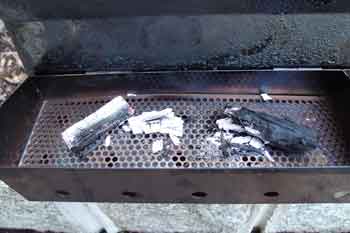
Partly burned wood hunks |
| Pellet Smoker |
Temp (probe) |
CO (ppm) |
CO/CO2 ratio |
NO (ppm) |
O2(%) |
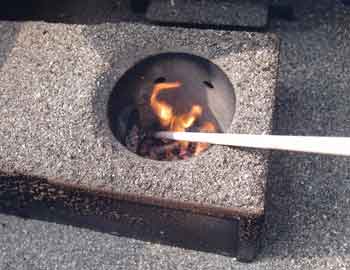
Pellet grill burner on low. Mostly embers. Ceramic thermocouple in embers |
800-1000F |
1000-2000 |
0.1 to 0.5 |
50 ppm |
16-18% |
| |
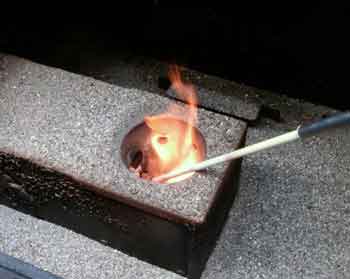
pellet smoker burner cup on HIGH. Ceramic sheathed thermocouple in flame. |
1800F-1900F |
5000 |
0.3 |
10 ppm |
19% |
| When the fan speeds up, the flame dramatically increases in size, and the CO content rises |
| Charcoal Briquette in Chimney |
Temp (probe) |
CO (ppm) |
CO/CO2 ratio |
NO (ppm) |
O2 (ppm) |
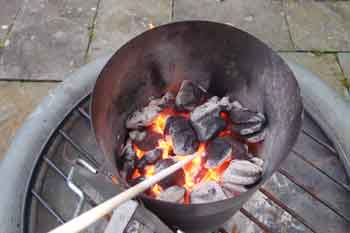
70 Kingsford blue briquettes. Ceramic probe inserted in fire center |
Early flame:
1700F |
>10,000 ppm |
|
50 ppm |
|
Red Coals:
1950F |
1000-3000 ppm |
|
170 ppm |
|
White Coals:
2150F
|
700-1000 ppm |
|
50-100 ppm |
|
| Gases measured 6" above chimney, where temperature is ~1000F-1400F. Higher temperatures with white coals also generated greater airflow, thus dropping ppms |
| Lump Charcoal in Chimney |
Temp (probe) |
CO (ppm) |
CO/CO2 ratio |
NO (ppm) |
O2 (ppm) |
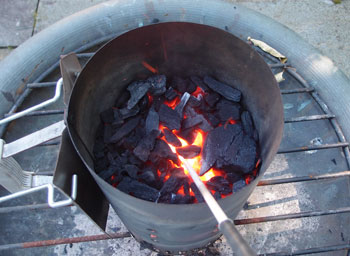
Royal Oak lump charcoal, ceramic sleeved thermocouple |
1400F |
7000 |
.14 |
40 |
14% |
| 1800F |
>9000 |
.06 |
90 |
6% |
Temperature measured in brightest section of coals. Gases measured just below chimney lip. The 1400F temperature reflects dull red coals, the 1800F brighter red. But still cooler than charcoal briquettes. Some ember spitting.
Lump can burn hotter than briquette, but often small chips fill the gaps between the large, blocking air flow. So in actuality somewhat cooler.
Lump charcoal is often sold as lower polluting, especially lower NO by a factor of 3. These measurements are consistent with that rough air pollution advantage. |
| Charcoal Cabinet Smoker |
Temp (probe) |
CO (ppm) |
CO/CO2 ratio |
NO (ppm) |
O2 (ppm) |
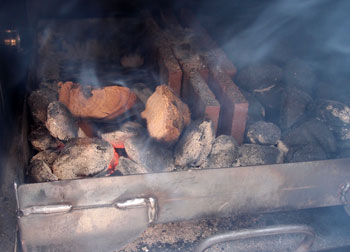
Kingsford Blue charcoal briquettes in minion arrangement. Two oak wood hunks shown on coals. With door closed, embers hardly glow. |
NO Wood hunk
900F-
1100F |
9000 |
0.2 |
20 |
15% |
Wood hunk
900F-
1100F |
>10,000 |
0.17 |
10 |
15% |
Temperature controlled to 250F with PartyQ Guru and fan. Important to assure only ~10% of the briquettes are lit at any one time, or the fan cycles infrequently, causing dark gray smoke and high CO levels
NO levels are low due to poor oxygen supply and low coal temperatures. But will result in a smoke ring on most days. |
| Smokenator in Weber |
Temp (probe) |
CO (ppm) |
CO/CO2 ratio |
NO (ppm) |
O2 (ppm) |
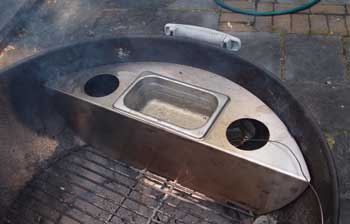
Kingsford Blue charcoal briquettes. Two oak wood hunks shown on coals. With lid and temperature 250F, embers hardly glow. |
Avg temp
500F-700F
Max temp on coal
1400F
|
>>10,000 |
0.7 |
<10 |
5% |
NO levels are low due to poor oxygen supply and low coal temperatures. But will result in a smoke ring on most days.
|
| Wood Fire |
Temp (probe) |
CO (ppm) |
CO/CO2 ratio |
NO (ppm) |
O2 (ppm) |

temperature measured in orange flames with ceramic sleeved probe |
1400F to 1600F |
4000-10,000 |
0.15 to 0.3 |
20-75 |
14% -18% |
The fire is not uniform, so the measurements vary wildly depending on the probe location and winds.
While most of the nitrogen compounds were in the form of nitric oxide, there were 2-5 ppm of other nitrogen oxides |
| Gas Smoker |
Temp (probe) |
CO (ppm) |
CO/CO2 ratio |
NO (ppm) |
O2 (ppm) |
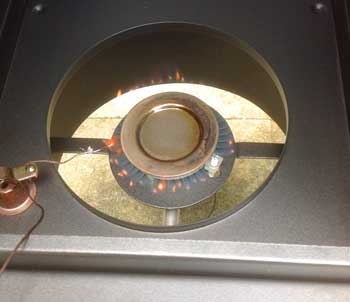
Charbroil vertical cabinet smoker. Temperature measured in orange flames with bulb sleeved probe |
2170F |
no wood
3 ppm |
0.0001 |
20 ppm |
17.5% |
| 2170F |
with wood
500 ppm |
0.15 |
20 ppm |
17% |
The wood tray does not turn dull red though heated directly by the flames- actual temperature around 700-800F. So the wood chars slowly and with too little oxygen to produce much NO.
Gases measured in center of smoker |
| Natural Gas Kitchen Burner |
Temp (probe) |
CO (ppm) |
CO/CO2 ratio |
NO (ppm) |
O2 (ppm) |
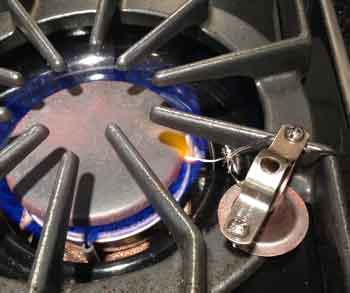
kitchen burner with small thermocouple inserted in flame |
Ceramic TC
1950F
Bulb TC:
2300F
|
15-30 ppm |
.0005-.001 |
<10 ppm |
17% |
Gases measured 6" above center of burner (850F)
Note ceramic TC is larger than flame, so underestimates temperature.
Clearly, almost all the natural gas is consumed and turned into carbon dioxide- very little becomes CO or NO. But the temperature is high enough to produce a little NO from the nitrogen in air. Which is why some gas smokers "pink" cooked turkey, where the light color is visible against the white meat. |
| Propane Gas Grill |
Temp (probe) |
CO (ppm) |
CO/CO2 ratio |
NO (ppm) |
O2 (ppm) |
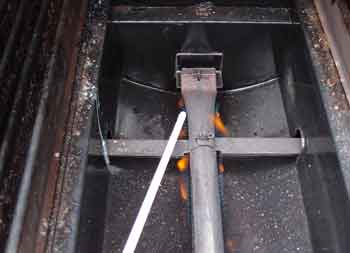
ceramic sheathed thermocouple in grill propane flame |
Ceramic TC
1600F
Bulb TC:
2000F |
25-50 ppm |
.003 - .004 |
<3 ppm |
19.5-20% |
| Below grates, lid open |
400 ppm |
.005 |
10-20
ppm |
15% |
| above grates, lid closed |
50-100 ppm |
.002 |
10-20 |
18% |
With 100% combustion there would be no oxygen left in the exhaust. These oxygen levels are close to 21%, the amount in free air. Which implies there is 2-3 time more (e.g. "excess") air than required for combustion in a gas grill.
Clearly, almost all the natural gas is consumed and turned into carbon dioxide- very little becomes CO or NO.
With 4 hamburgers cooking on grill and lid open, drippings combust on the flame diverter and CO>1000 ppm and NO~5 ppm
Note the ceramic TC is larger than flame, so it underestimates temperature. |
|


















